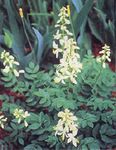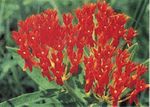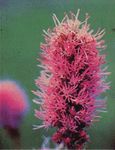Perennial Flowers for Specific Uses in Oklahoma
←
→
Page content transcription
If your browser does not render page correctly, please read the page content below
Oklahoma Cooperative Extension Service HLA-6410
Perennial Flowers for Specific
Uses in Oklahoma
Michael A. Schnelle
Assistant Professor, Extension Ornamentals Oklahoma Cooperative Extension Fact Sheets
Floriculture Specialist are also available on our website at:
http://osufacts.okstate.edu
Douglas C Needham
Assistant Professor, Floriculture
John M. Dole Gaillardia (Gaillardia x grandiflora)
Assistant Professor, Floriculture Gayfeather (Liatris spp.)
*Gladiolus (Gladiolus x hortulanus)
A perennial is any plant that lives and flowers more than Hollyhock (Alcea rosea)
two years. Many of the plants below may be marginally hardy Iris, Bearded (Iris hybrids)
in northern locations of the state or in southern locations where Iris, Japanese (Iris ensata)
summers are particularly hot. Some of the plants below are
Larkspur (Delphinium elatum)
grown from bulbs or similar underground structures. Species
Lily, Garden (Lilium hybrids)
marked with an asterisk need to be lifted each fall, stored
over winter, and replanted the following spring. Consult with Lily of the valley (Convallaria majalis)
a reputable garden center or greenhouse for advice on peren- Maltese cross (Lychnis chalcedonica)
nials best suited for your particular location. Narcissus (daffodils) (Narcissus hybrids)
Peony (Paeonia hybrids)
Peony, Tree (Paeonia suffruticosa)
Cut Flowers
Phlox, Tall (Phlox paniculata)
Below are a few of the more commonly grown species for
Pincushion Flower (Scabiosa caucasica)
use in arrangements and bouquets that are equally attractive
in the flower garden. See Extension Fact Sheet HLA-6407 Poppy, Iceland (Papaver nudicaule)
for ideas on flower arrangements and bouquets. Growers Poppy, Oriental (Papaver orientale)
should refer to Extension Fact Sheet HLA-6426, “The Care Sage, Mealycup (Salvia farinacea)
and Handling of Cut Flowers.” Salvia, Perennial (Salvia superba)
Statice (Limonium latifolium)
Ageratum, Hardy (Eupatorium coelestinum) Sunflower, False (Heliopsis helianthoides var. scabra)
Astilbe (Astilbe x arendsii) Tulip (Tulipa hybrid)
Buby’s breath (Gypsophila paniculata) Yarrow, Fernleaf (Achillea filipendulina)
Bachelor’s buttons (Centaurea montana ‘Mountain Bluet’) Yarrow, Common (Achillea millefolium)
Bee balm (Monarcla didyma) Yarrow, Woolly (Achillea tomentosum)
Blackberry lily (Belamcancla chinensis)
Black-eyed Susan (Rudbeckia hirta var. pulcherrima) Showy Foliage
Bleeding heart (Dicentra eximia) (Dicentra spectabilis) These plants may be used to lend interest to surround-
Butterfly weed (Asclepias tuberosa) ing flowering plants or for foliage in bouquets. Many of these
*Calla lily (Zantedeschia aethiopica) species are equally striking when planted alone.
*Canna (Canna x generalis)
Clematis, Jackman (Clematis x jackmanii) Ajuga (Ajuga reptans)
Columbine (Aquilegia hybrids) Bergenia (Bergenia cordifolia)
Coneflower (Echinacea purpurea) Bishop’s goutweed (Aegopodium podagraria ‘Variegatum’)
Coralbells (Heuchera sanguinea) *Caladium (Caladium x hortulanum)
Coreopsis (Coreopsis lanceolata) Candytuft, Evergreen (Iberis sempervirens)
Dahlia (Dahlia hybrids) *Elephant’s-ear (Colocasia esculenta)
Daisy, Painted (Chrysanthemum coccineum) Fern, Christmas (Polystichum acrostichoides)
Daisy, Shasta (Chrysanthemum x superbum) Fern, Dragontail (Asplenium ebenoides)
Fountain grass (Pennisetum alopecuroides) Fern, Lady (Athyrium filix-femina)
Foxglove (Digitalis purpurea) Fern, Marginal shield (Dryopteris marginalis)
Division of Agricultural Sciences and Natural Resources • Oklahoma State UniversityFigure 1. Gayfeather (Liatris spp.) Figure 2. Iris (Iris hybrids)
Figure 3. Japanese Bleeding Heart (Dicentra spectabilis) Figure 4. Spike Speedwell (Veronica spicata)
Figure 5. Fragrant Plantain-Lily (Hosta plantaginea)
Figure 6. Giant Onion (Allium giganteum)
6410-2Figure 7. Garden Peony (Paeonia lactiflora)
Figure 8. Ferlead Yarrow (Achillea filipendulina)
Figure 10. Butterfly Bush (Asclepias tuberosa)
Figure 9. Astible (Astible x arendsii)
Figure 11. Daylily (Hemerocallis species)
Figure 12. Gas Plant (Dictamnus albus)
6410-3Fern, Royal (Osmunda regalis) Red-hot poker (Kniphofia uvaria)
Fern, Sensitive (Onoclea sensibilis) Sedum (Sedum spectabile)
Fescue, Blue (Festuca ovina ‘Glauca’) Sneezeweed (Helenium autumnale)
Grass, Fountain (Pennisetum alopecuroides) Sunflower, False (Heliopsis helianthoides var. scabra)
Grass, Plume (Erianthus ravennae) Thistle, Small Globe (Echinops ritro)
Hen-and-chickens (Sempervivum tectorum) Yarrow (Achillea spp.)
Hosta (Hosta hyacintha) Yucca (Yucca filamentosa)
Japanese Blood Grass (Imperata cylindrica var. rubra ‘Red
Baron’) Prefer or Tolerate Light Shade
Japanese Sweet Flag (Acorus gramineus ‘Variegata’) These plants may need protection from the sun. Many
Lamb’s ear (Stachys byzantina) of these will suffer without protection from harsh Oklahoma
Lavendar cotton (Santolina chamaecyparissus) conditions.
Plantain lily, Wavy-leaved (Hosta undulata)
Plantain lily (Hosta lancifolia var. albomarginata) Ajuga (Ajuga reptans)
Ribbon grass (Phalaris arundinacea var. picta) Astilbe (Astilbe x arendsii)
Rue (Ruta graveolens) Bergenia (Bergenia cordifolia)
Sedum (Sedum spp.) Bleeding heart (Dicentra eximia) (D. spectabilis)
Yucca (Yucca filamentosa) *Caladium (Caladium x hortulanum)
Wormwood (Artemisia schmidtiana ‘Silver Mound’) Coralbells (Heuchera sanguinea)
Daylily (Hemerocallis spp.)
Large Background Fern, Dragontail (Asplenium ebenoides)
Tall plants can serve as background for shorter perenni- Fern, Lady (Athyriun filix-femina)
als or annuals. These species may also be used as barriers Fern, Royal (Osmumda regalis)
to hide unsightly areas. Be certain when buying these plants Four O’Clocks (Mirabilis jalapa)
that you get a tall cultivar and not a dwarf. Gloxinia, Hardy (Incarvillea delavayi)
Hibiscus (Hibiscus moscheutos)
Astilbe (Astilbe x arendsii) Indigo, False (Baptisia australis)
Baby’s breath (Gypsophila paniculata) Lilac cranesbill (Geranium himalayense)
Bee balm (Monarda didyma) Lily-of-the-valley (Convallaria majalis)
Butterfly weed (Asclepias tuberosa) Liriope (Liriope spicata)
*Canna (Canna x generalis) Moneywort (Lysimachia nummularia)
Chrysanthemum, Hardy (Dendranthemum grandiflorom) Pachysandra (Pachysandra terminalis)
Columbine (Aquilegia hybrids) Pasqueflower (Anemone pulsatilla)
Coneflower, Purple (Echinacea purpurea) Plantain lily (Hosta spp.)
Crown Imperial (Fritillaria imperialis) Plumbago (Ceratostigma plumbaginoides)
Daylily (Hemerocallis spp.) Solomon’s seal (Polygonatum biflorum)
*Elephant’s-ear (Colotasia esculenta) Spiderwort, Virginia (Tradescantia x andersoniana)
Four O’Clocks (Mirabilis jalapa) Sweet woodruff (Galium odoratum)
Foxglove (Digitalis purpurea) Violet, Sweet (Viola odorata)
Gas plant (Dictamnus albus)
*Gladiolus (Gladiolus x hortulanus) Edging/Borders/Ground Covers
Hibiscus (Hibiscus moschutos)
Ajuga (Ajuga reptans)
Hollyhock (Alcea rosea)
Bergenia (Bergenia cordifolia)
Indigo, False (Baptisia ausralis)
Candytuft (Iberis sempervirens)
Iris, Bearded (Iris hybrids)
Cinquefoil (Potentilla nepalensis)
Jupitersbeard (Centranthus ruber)
Crocus (Crocus hybrids)
Lily, Garden (Lilium hybrids)
Crocus, Autumn (Colchicum autumnale)
Loosestrife (Lysimachia clethroides)
Fescue, Blue (Festuca ovina ‘Glauca’)
Magic lily (Lycoris squamigera)
Flax (Linum perenne)
Onion, Giant (Allium giganteum)
Fleeceflower, Reynoutria (Polygonum cuspidatum var.
Pampas grass (Cortaderia selloana)
compactum)
Peony (Paeonia hybrids)
Peony, Tree (Paeonia suffruticosa)
Phlox, Tall (Phlox paniculata)
6410-4Glory of the snow (Chionodoxa luciliae) Dried Flowers or Showy Fruit
Goutweed, Bishop’s (Aegopodium podograria ‘Variegatum’) Below are plants with flowers or fruit that can easily be
Grape hyacinths (Muscari album) dried for everlasting arrangements. Other species not listed
Hen-and-chickens (Sempervivum tectorum) may be suitable but require much more care for drying and
Lamb’s ear (Stachys byzantina) preservation.
Lily-of-the-valley (Convallaria majalis)
Liriope (Liriope spicata) Baby’s breath (Gypsophila paniculata) - flowers
Mallow, Poppy (Callirhoe involucrata) Blackberry lily (Belamcanda chinensis) - seed pods
Moneywort (Lysimachia nummularia) Butterfly weed (Asclepias tuberosa) - seed pods
Pachysandra, Japanese (Pachysandra terminalis) Chinese lantern plant (Physalis alkekengi) - seed pods Gay-
Pasque flower (Anemone pulsatilla) feather (Liatris spp.) - flowers
Penstemon (Penstemon spp.) Indigo, False (Baptisia australis) - seed pods
Phlox, Moss (Phlox subulata) Money plant (Lunaria annua) - seed pods
Plumbago (Ceratostigma plumbaginoides) Pampas grass (Cortaderia selloana) - flower and seeds
Primrose, Missouri (Oenothera missouriensis) Quaking grass (Briza media) - flowers and seeds
Sea pink (Armeria maritima) Statice (Limonium latifolium) - flowers
Sedum (Sedum spp.) Thistle, Small globe (Echinops ritro) - flowers
Strawberry, Barren (Waldsteinia fragariodes) Yarrow (Achillea spp.) - flowers
Squill, Siberian (Scilla siberica)
Snowdrop (Galanthus nivalis) Categories above are merely suggestions for placement of
Violet, Sweet (Viola odorata) perennials. The categories are by no means comprehensive,
Violet, Horned (Viola cormuta) but rather common uses for the specific plants listed. Check
with personnel in your local greenhouse or garden center for
additional advice on what plants perform well in your area.
Vines Also, bookstores often carry a wide array of books on garden-
The species below serve many purposes such as ing with perennials.
screening and can he grown on trellises, fences, and gaze-
bos. Books
Armitage, Allen. Herbaceous Perennial Plants. Varsity Press,
Clematis, Jackman (Clematis x jackmanii)
Inc. Athens, Georgia. 1989.
Everlasting Pea (Lathryus latifolius)
Still, Steven M. Manual of Herbaceous Ornantental Plants.
Rose, Climbing (Rosa spp.) Stipes Publishing Company. 1988.
6410-5The Oklahoma Cooperative Extension Service
Bringing the University to You!
The Cooperative Extension Service is the largest, • It provides practical, problem-oriented education
most successful informal educational organization for people of all ages. It is designated to take the
in the world. It is a nationwide system funded and knowledge of the university to those persons
guided by a partnership of federal, state, and local who do not or cannot participate in the formal
governments that delivers information to help people classroom instruction of the university.
help themselves through the land-grant university
• It utilizes research from university, government,
system.
and other sources to help people make their own
Extension carries out programs in the broad catego- decisions.
ries of agriculture, natural resources and environment;
• More than a million volunteers help multiply the
family and consumer sciences; 4-H and other youth;
impact of the Extension professional staff.
and community resource development. Extension
staff members live and work among the people they • It dispenses no funds to the public.
serve to help stimulate and educate Americans to
• It is not a regulatory agency, but it does inform
plan ahead and cope with their problems.
people of regulations and of their options in meet-
Some characteristics of the Cooperative Extension ing them.
system are:
• Local programs are developed and carried out in
• The federal, state, and local governments co- full recognition of national problems and goals.
operatively share in its financial support and
• The Extension staff educates people through
program direction.
personal contacts, meetings, demonstrations,
• It is administered by the land-grant university as and the mass media.
designated by the state legislature through an
• Extension has the built-in flexibility to adjust its
Extension director.
programs and subject matter to meet new needs.
• Extension programs are nonpolitical, objective, Activities shift from year to year as citizen groups
and research-based information. and Extension workers close to the problems
advise changes.
Oklahoma State University, in compliance with Title VI and VII of the Civil Rights Act of 1964, Executive Order 11246 as amended, Title IX of the Education Amendments of 1972, Americans
with Disabilities Act of 1990, and other federal laws and regulations, does not discriminate on the basis of race, color, national origin, gender, age, religion, disability, or status as a veteran in
any of its policies, practices, or procedures. This includes but is not limited to admissions, employment, financial aid, and educational services.
Issued in furtherance of Cooperative Extension work, acts of May 8 and June 30, 1914, in cooperation with the U.S. Department of Agriculture, Robert E. Whitson, Director of Cooperative Ex-
tension Service, Oklahoma State University, Stillwater, Oklahoma. This publication is printed and issued by Oklahoma State University as authorized by the Vice President, Dean, and Director
of the Division of Agricultural Sciences and Natural Resources and has been prepared and distributed at a cost of $1.62 per copy. 0604
6410-6You can also read



























































